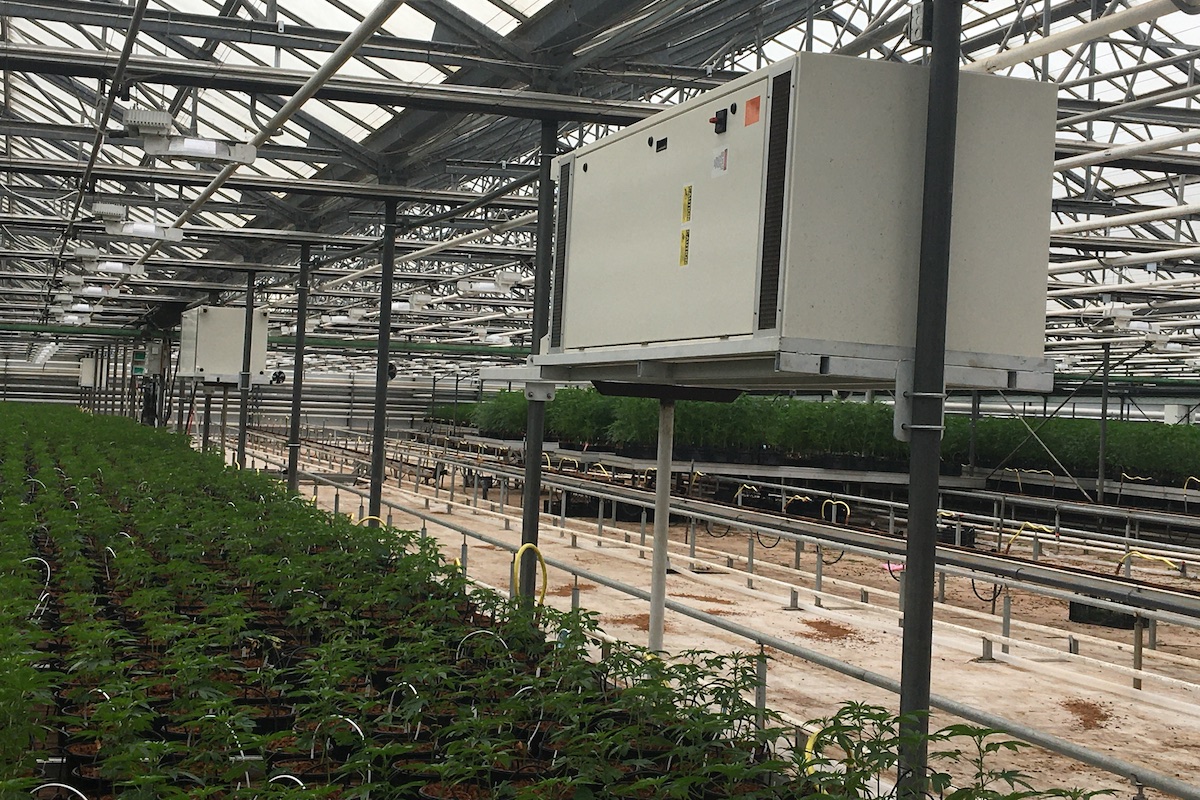Carpinteria Cannabis and the Lingering Smell of Pot
Odor Threshold for Greenhouse Property Lines Would Be a Start, but It Won’t Solve Problem, Residents Say

A county plan for tackling the “skunky” smell of pot in the Carpinteria Valley was presented to the Planning Commission this week, amid a flurry of letters from residents who said it didn’t go far enough.
Under the proposal by county Planning & Development, inspectors with “trained noses” would investigate odor complaints in the valley, a mecca for the cannabis greenhouse industry, by measuring the smell along greenhouse property lines. They would sniff the air through Nasal Rangers, handheld gadgets that look like oversized hair dryers.
Any odor of pot rated by an inspector as stronger than “noticeable” and lasting for at least three minutes would require the growers to take some action — adjust their odor control equipment, conduct diagnostic testing, or install better technology.
County inspections of the greenhouses themselves would be performed quarterly during the first year of operations, as they are now, and annually thereafter, unannounced. Growers would be required to install “run-time” meters showing when their equipment was or was not functioning.
These amendments to the county’s 2018 cannabis ordinance would provide “an objective standard or threshold that is measurable and enforceable” and would help Planning & Development “to better identify, evaluate, and enforce cannabis related nuisance odors” in the valley, according to a staff report to the commission.
For implementation, the odor controls would require a commission recommendation, a majority vote of the county Board of Supervisors and final approval by the state Coastal Commission, a process that could take more than a year.

‘Disrespecting the Voters?’
The county Planning Commission, running well behind schedule on Wednesday, heard a summary of the staff report but continued the hearing to November 6 for oral public comment. Two dozen letters to the commission were rushed to the commission last week, including statements from Concerned Carpinterians, the Coalition for Responsible Cannabis, Carpinteria Valley Association and City of Carpinteria, broadly criticizing the proposed odor controls and asking for more time to review them.

Lionel Neff, a coalition board member, said property line testing and an odor threshold would be “significant steps in the right direction.” However, he said, “the proposed amendments simply will not address the pervasive and perpetual nuisance to the community…. Community members have suffered for years, and this proposal does not move us quickly enough to solutions.”
For starters, some residents said, the county should not take any action on odor control until county Supervisor-elect Roy Lee, a Carpinteria City councilmember, takes office for the 1st District on January 1, replacing Das Williams, a Carpinterian who was a chief architect of the cannabis ordinance.
“Isn’t it disrespecting the voters in the 1st District to push through ordinance amendments right before seating the new 1st District Supervisor?” asked Tim Bliss, who lives on Casitas Pass Road. Another member of the Bliss family joined the lawsuit that was filed last year by the coalition against Valley Crest Farm and Ceres Farms, two large cannabis greenhouse operations at 5980 and 6030 Casitas Pass Road.
Most of the 20 “grows” currently operating in the valley, including Valley Crest and Ceres, rely solely on “misting” systems that are designed to mask the smell of pot after it escapes through the greenhouse roof vents and into the outside air. County records show that only six greenhouse operations are equipped with carbon filters, called “scrubbers,” which have been shown to eliminate most of the smell of pot before it can escape through the vents.
The letters to the commission from city officials and the citizens’ groups repeated their longstanding demand that the county amend its ordinance to require the installation of scrubbers in every cannabis greenhouse.
“Please set carbon scrubber requirements and monitoring thresholds that you would want if you lived in a Carpinteria home adjacent to a cannabis facility and your children studied and played at a Carpinteria school near a cannabis facility,” said Reece Duca, a longtime valley resident.
‘A Lot Has Been Accomplished’
According to the staff report, Geosyntec Consultants, a Santa Barbara engineering firm, recorded 335 measurements with Nasal Rangers at the property lines of valley greenhouses during two four-day periods this year — one in May and one in August — to evaluate the smell of cannabis. The vast majority of these measurements were classified as “no odor,” “faint or transient odor” or “mild to transient odor” — all below the threshold for inspection that the county is proposing.
More noticeable cannabis odor was recorded at greenhouses on Foothill Road that have long been the target of residents’ complaints — in the 3500 and 4400 blocks and the 4500 block near Carpinteria High School — and in the 5600 and 5700 blocks of Casitas Pass Road.

Geosyntec also tested three greenhouse operations indoors, predictably finding strong levels of odor there; but at the greenhouse property lines, the smell dropped to negligible levels. This data indicates that odor control technology “is capable of significantly reducing cannabis odor from inside the facilities, compared to outside the facilities,” the staff report said.
Between December 2022 and April 2024, Geosyntec inspected 50 “misting” systems and scrubbers at 22 cannabis operations in the valley; and two near Buellton. In most cases, the company found that growers were complying with their county-approved odor-control plans, and their systems were working.
In a letter to the commission, CARP Growers, an industry group representing most of the greenhouse owners in the valley, said that Geosyntec’s work “was comprehensive and seems to obviate the need for substantial amendments” to the county’s cannabis ordinance. The group objected to what it viewed as an “arbitrary” threshold for odor monitoring at the property lines; and it noted that many greenhouses were “substantial distances from residential areas.”
The growers said they would support a requirement for annual odor control inspections of greenhouse operations, but that the cost should be deducted from the county taxes they pay.
“It is clear from the work contained in the staff letter, prepared by your staff and consultants, that a lot has already been accomplished related to cannabis odor control,” the group stated.
‘A Disadvantaged Community‘
Since early 2016, county records show, valley residents have submitted more than 3,900 odor complaints with Planning & Development regarding the smell of pot and the “laundromat” smell of the misting systems. But there has been no way to determine which “grow” was to blame.
Despite the prevalence of the misting systems, the smell of pot lingers in hot spots around the valley, including La Mirada, Padaro Lane, the Polo Condos, the Cate School campus, and along Foothill Road. This year to date, Carpinterians have filed 253 odor complaints with the county, down dramatically from 1,200 complaints in 2021. But some residents say they no longer bother to fill out the forms.
“As a resident of Carpinteria, and having had to smell cannabis almost every day for seven years, I implore you to get this amendment correct,” Merrily Peebles wrote to the commission, attaching copies of her many complaints from the foothill neighborhood of La Mirada Drive.
“Carpinteria has become a disadvantaged community,” Peebles said. “We put up with odor that causes possible physical aliments such as asthma, limits our ability to socialize outdoors or keep our windows open, and decreases our property value…. I have mostly stopped reporting this year, as it seems useless.”

Some residents said the proposed odor threshold for greenhouse property lines should be lowered to “faint” or “very faint” instead of “noticeable.” Others, including Peebles, said it should be zero. “We don’t want to smell it, ever,” one resident said. Some wanted the county to fine growers and revoke their business licenses if they failed to control the smell.
Many of the letters raised objections to a continued reliance on odor complaints. The county’s proposal would trigger measurements at the property lines of a greenhouse only if three people submitted complaints within 60 days or five people did so within 24 hours. Residents also noted that a Nasal Ranger would not help neighborhoods such as La Mirada that are not next to greenhouses. In some places, the smell wafts in on the wind.
The proposed ordinance amendments, Supervisor-elect Lee wrote to the commission, “should prioritize an overhaul” of the “existing odor complaint system” that has frustrated many of his constituents for years.
“We have a critical opportunity to correct these deficiencies and to restore public trust in our local governance,” Lee said.
The concept of measuring the smell of pot at greenhouse property lines was considered years ago by the Planning Commission, but it was never adopted. Then, in 2022, the county Board of Supervisors contracted with Geosyntec for on-call odor monitoring; and in April this year, the board asked Planning & Development to propose ordinance amendments on odor control for the Carpinteria Valley.
In two separate studies that are underway, staff planners said, Geosyntec and Southern California Edison are looking into potential electrical demands related to the installation of scrubbers in valley greenhouses; and Planning & Development is studying how to improve odor control at outdoor cannabis operations, chiefly west of Buellton. Of 44 permitted North County “grows” in open fields or under hoops, only five have been required to install odor-control equipment.
Melinda Burns is an investigative journalist with 40 years of experience covering immigration, water, science and the environment. As a community service, she offers her reports to multiple publications in Santa Barbara County, at the same time, for free.
Premier Events
Fri, Jan 31
5:00 PM
Santa Barbara
Artist Talk at Art & Soul on State Street
Wed, Jan 22
5:30 PM
Santa Barbara
Talk: “Raising Liberated Black Youth”
Sun, Jan 26
11:00 AM
Santa Barbara,
17th Annual Santa Barbara Community Seed Swap 2025
Thu, Jan 30
8:00 PM
Solvang
Lucinda Lane Album-Release Show, at Lost Chord Guitars
Fri, Jan 31
9:00 AM
Goleta
AARP FREE TAX PREPARATION
Fri, Jan 31
5:00 PM
Santa Barbara
Artist Talk at Art & Soul on State Street
Sat, Feb 08
10:00 AM
Santa Barbara
Paseo Nuevo Kids Club
Sat, Feb 08
12:30 PM
Solvang
Garagiste Wine Festival
Tue, Feb 11
8:00 PM
Santa Barbara
SBIFF – Tribute to Timothée Chalamet
Thu, Feb 13
8:00 PM
Santa Barbara
SBIFF – Tribute to Adrien Brody and Guy Pierce
Fri, Jan 31 5:00 PM
Santa Barbara
Artist Talk at Art & Soul on State Street
Wed, Jan 22 5:30 PM
Santa Barbara
Talk: “Raising Liberated Black Youth”
Sun, Jan 26 11:00 AM
Santa Barbara,
17th Annual Santa Barbara Community Seed Swap 2025
Thu, Jan 30 8:00 PM
Solvang
Lucinda Lane Album-Release Show, at Lost Chord Guitars
Fri, Jan 31 9:00 AM
Goleta
AARP FREE TAX PREPARATION
Fri, Jan 31 5:00 PM
Santa Barbara
Artist Talk at Art & Soul on State Street
Sat, Feb 08 10:00 AM
Santa Barbara
Paseo Nuevo Kids Club
Sat, Feb 08 12:30 PM
Solvang
Garagiste Wine Festival
Tue, Feb 11 8:00 PM
Santa Barbara
SBIFF – Tribute to Timothée Chalamet
Thu, Feb 13 8:00 PM
Santa Barbara






















You must be logged in to post a comment.